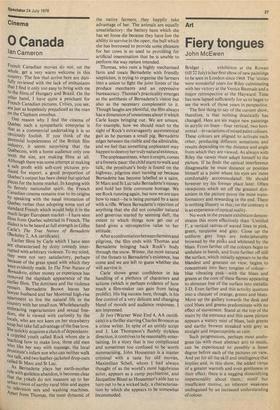Fiery tongues
John McEwen
Bridget . _ exhibition at the Rowan (till 22 July) is her first strow of new paintings to be seen in London since 1969. The 'sixties were wonderful years for Riley culminating with her victory at the Venice Biennale and a major retrospective at the Hayward. Time has now lapsed sufficiently for us to begin to see the work of those years in perspective.
The first thing to say of the current show, therefore, is that nothing drastically has changed. Here are six major new paintings in acrylic on linen—four vertical, two horizontal—in variations of mixed paint colours. These colours are aligned to activate each other, producing different. sensations and results depending on the distance and angle from which they are viewed. As always with Riley the viewer must adapt himself to the picture. If he finds the optical interference disagreeable he must distance or position himself at a point where his eyes are more comfortably accommodated. He should however try his former place later. Often viewpoints which set off the greatest dynamism in the picture prove the most transformatory and rewarding in the end. There is nothing illusory in this; on the contrary it is an experience of optical reality.
No work in the present exhibition demonstrates this more effectively than 'Untitled I', a vertical canvas of waved lines in pink, green, turquoise and grey. Close up the uniform grey lines are indecipherably browned by the pinks and whitened by the blues. From farther off the colours begin to undulate in bands, and from farther off still the surface, which initially appears to be the blandest and greenest on view, begins to concentrate into fiery tongUes of colour— blue vibrating pink—with the blues and greens at the core of these flames appearing to shimmer free of the surface into metallic 3-D. Even farther and this activity quietens into a chequer of orange, greens and blues. Move up the gallery towards the desk and cool blues and greens predominate with no effect of movement. Stand at the top of the stairs by the entrance and this same picture appears a watery mist of blues, lush greens and earthy browns streaked with grey as straight and imperceptible as rain.
Such progressions, perhaps most analogous (as with most abstract art) to music, can be experienced to possibly a lesser degree before each of the pictures on view. And yet for all the skill and intelligence that implies and, in this show, the added virtue of a greater warmth and even gentleness in their effect, there is a nagging dissatisfying impersonality about them,: motif but insufficient motive, an inherent weakness undisguised by an increased understanding of colour.


































 Previous page
Previous page